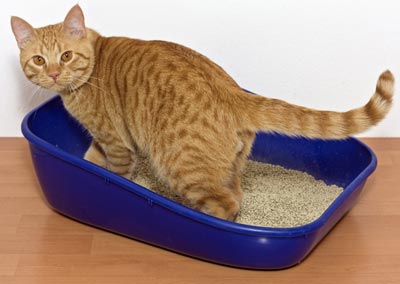Toxoplasmosis in Cats

Toxoplasmosis in cats is caused by a parasite called Toxoplasma gondii. Toxoplasmosis can occur in most mammals, including humans, but cats are the definitive hosts, meaning that the parasite's eggs can only be produced in a cat.
The Life Cycle of Toxoplasma Gondii
Cats get T. gondii when they eat prey or infected raw meat that contains it. The parasite infects the cat's digestive tract, and eggs are produced there. These eggs, or oocysts, are then released into the environment within the cat's feces.
Once the oocysts are in the environment, they sporulate, which takes at least 24 hours. Then they can infect people and other animals.
Inside intermediate hosts (any species other than cats), the parasite doesn't produce oocysts, but it does form cysts in the muscle and various other body tissues. If those tissues are ingested by a predator, they infect that animal.
Signs of Toxoplasmosis in Cats
The majority of the time, cats infected with T. gondii do not show any signs of sickness. However, if they do develop illness, or toxoplasmosis, they may show some of these signs:
- Fever
- Lethargy
- Decreased or absent appetite
Signs are caused when the cyst stage of the infection isn't contained by the cat's immune system, so other signs depend on where those cysts are. For instance, cysts in the lungs can cause signs of respiratory illness like coughing, labored breathing, and pneumonia. Cysts in the retinas can cause blindness, and the central nervous system can be infected, resulting in neurological signs like seizures, circling, head pressing, and personality changes.
Cats with compromised immune systems are at higher risk of developing toxoplasmosis when they are infected with T. gondii, especially cats with feline leukemia or FIV.
Can Humans Get Toxoplasmosis from Cats?
Humans can become infected by T. gondii from their cat if they ingest some infected feces after the oocysts have sporulated. That means that someone would have to handle the stool of a cat about 3-10 days after that cat became infected and 1-3 days after the infected stool was passed. Then the person would need to eat something with their hands without washing in between.
Because cats get T. gondii primarily from eating infected prey, indoor cats aren't usually exposed to it, and the specific conditions mentioned above are difficult to meet, so a person getting toxoplasmosis from their own indoor cat is rare.
People more commonly become infected by T. gondii when they eat undercooked meat, poorly washed vegetables, or eat something with bare hands after working in the garden. This is because outdoor cats often use garden soil as a litter box, and those cats are more likely to be infected than indoor cats.
Immune-compromised people are at higher risk of contracting toxoplasmosis and suffering from health problems as a result. Pregnant women are also a group that can be impacted by toxo more than the general population because a developing fetus can be severely injured by T. gondii.
Pregnant women and immune-compromised people should take extra care when handling cat feces, avoid eating undercooked meat, thoroughly wash vegetables before eating them, and use gloves while gardening.
People should consult with their physicians for specific recommendations for avoiding toxoplasmosis.
Diagnosis of Toxoplasmosis in Cats
A veterinarian may suspect toxoplasmosis in a cat because of clinical signs. Blood tests can be run to look for antibodies to T. gondii. High antibody levels in a cat showing consistent signs of illness indicate an active infection.
T. gondii can sometimes be identified in a stool sample, but because cats shed oocysts for such a short time, this is not a reliable way to diagnose infection.
Treatment of Feline Toxoplasmosis
Cats with toxo are treated with a specific antibiotic, and most recover well as long as treatment is started early and continued past the resolution of clinical signs.
You May Also Like These Articles:
Single Celled Parasites of Cats
Tips for Good Litter Box Cleaning
Zoonoses: Things Cats Can Spread to Humans
Cuterebra Infestations in Cats





